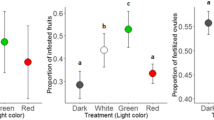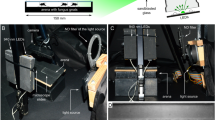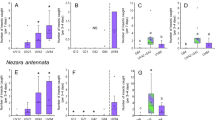Abstract
JEWELL1,2, in Tanganyika, showed that tsetse flies marked with fluorescent paint can be located at night by means of ultra-violet light resting on leaves. A portable petrol generator was his current supply (personal communication). Because such equipment is cumbersome, other workers3 have used a hand torch to search for flies painted with reflective glass beads mixed with glue.
This is a preview of subscription content, access via your institution
Access options
Subscribe to this journal
Receive 51 print issues and online access
$199.00 per year
only $3.90 per issue
Buy this article
- Purchase on Springer Link
- Instant access to full article PDF
Prices may be subject to local taxes which are calculated during checkout
Similar content being viewed by others
References
Jewell, G. R., Nature, 178, 750 (1956).
Jewell, G. R., Nature, 181, 1354 (1958).
Rennison, B. D., et al., Nature, 181, 1354 (1958).
Nash, T. A. M., Bull. Ent. Res., 48, 33 (1952).
Author information
Authors and Affiliations
Rights and permissions
About this article
Cite this article
McDONALD, W. Nocturnal Detection of Tsetse Flies in Nigeria with Ultra-Violet Light. Nature 185, 867–868 (1960). https://doi.org/10.1038/185867a0
Issue Date:
DOI: https://doi.org/10.1038/185867a0
Comments
By submitting a comment you agree to abide by our Terms and Community Guidelines. If you find something abusive or that does not comply with our terms or guidelines please flag it as inappropriate.



